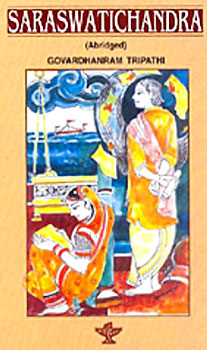 Sarasvatichandra is a Gujarati novel focusing on the issue of widow remarriage. It was written by Govardhanram Tripathi, a western-educated contemporary of the famous Gujarati poet Dalpatram. Govardhanram`s novel, Sarasvatichandra which was published in four parts between 1887 and 1902, is about the love of Sarasvatichandra, a young, wealthy, Hindu intellectual/poet of Mumbai for Kumud and the impossibility of this love being fulfilled in their marriage because Kumud is a widow. He is also committed to the cause of the nation.
Sarasvatichandra is a Gujarati novel focusing on the issue of widow remarriage. It was written by Govardhanram Tripathi, a western-educated contemporary of the famous Gujarati poet Dalpatram. Govardhanram`s novel, Sarasvatichandra which was published in four parts between 1887 and 1902, is about the love of Sarasvatichandra, a young, wealthy, Hindu intellectual/poet of Mumbai for Kumud and the impossibility of this love being fulfilled in their marriage because Kumud is a widow. He is also committed to the cause of the nation.
The model has been written in the Realist style and this allows Govardhanram to endow both Sarasvatichandra and Kumud with individual identity. Kumud is even represented as a `new woman`, educated, articulate, accomplished and sharing Sarasvatichandra`s dream of nation building. The reformist/nationalist debate on widow remarriage occupies the major space in this novel. Thus, in such a situation the issue acquires a certain respectability and also allows the middle class intellectuals to shed their embarrassment about their own very conservative patriarchal notions, since within the fictional space some of them even desire and support her marriage with Sarasvatichandra. The only social function Kumud has in the novel is, ironically, to deny herself, and women of her class in general, any real productive social function. Sarasvatichandra also makes use of several other narrative traditions. All these narratives are accommodated within the larger realist narrative mode centred on an individual`s life. All other narratives are related to this narrative.
What the author essentially does in this novel, like Dalpatram, is to reinforce the traditional patriarchy and redefine the middle-/upper-class men`s relation to women within that patriarchy. Thus, he defines the emerging bourgeois, patriarchal culture that defined Gujarat in the mid-nineteenth century.
This article is a stub. You can enrich by adding more information to it. Send your Write Up to content@indianetzone.com



















